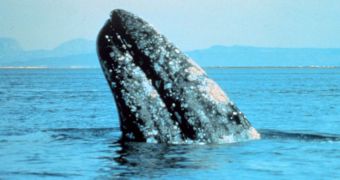A collaboration of paleontologists from the University of California in Berkeley (UCB) and the Smithsonian Institution determined that gray whales were able to survive past cycles of global warming and cooling by adopting a more varied diet.
When their very survival hung in the balance, the marine animals turned to eating more varied food than they would have otherwise. This provided them with the edge they needed to stay ahead, and avoid being wiped out like many other species were.
Gray whales employed these tactics for the past few million years, as evidenced by the new study of the California gray whale (Eschrichtius robustus). The work only covered the past 120,000 years directly, but the team says that the findings can be applied further back in time as well.
One of the most important discoveries was that a lot more gray whales existed along the coasts of the Pacific Oceans before humans got there. Today, those numbers stand at about 22,000, but scientists believe that two to four times as many whales may have once lived in this ecosystem.
Overall numbers dropped significantly in the 17th and 18th centuries, but conservation efforts started in the 1930s ensured that a genetically viable population survived to this day. In the early 20th century, after 75 years of systematic whaling, fewer than 1,000 gray whales remained in the world.
“There almost certainly were higher gray whale populations in the past,” explains David Lindberg, who holds an appointment as an evolutionary biologist at UCB. He is also a professor of integrative biology at the university.
He is a coauthor of the new research paper – which is published in the July 6 issue of the journal PLoS ONE – with SMithsonian curator of fossil marine mammals Nicholas D. Pyenson, a former student.
“We propose that gray whales survived the disappearance of their primary feeding ground by employing generalist filter-feeding modes, similar to the resident gray whales found between northern Washington State and Vancouver Island,” the team writes.
“A combination of low population numbers and a species migrating between places where humans didn’t bother them gave us the impression that gray whales have a stereotypical migratory and feeding behavior that may not be historically correct,” Lindberg explains further.
Gray whales' diets used to consists of worms and amphipods, but now the animals are beginning to eat krill and herring as well, just like their baleen whale relatives do. This strategy could be making them more evolutionary fit to withstand global warming.
The US National Science Foundation (NSF), the Natural Sciences and Engineering Research Council of Canada (NSERC) and the Smithsonian Institution provided the funds needed for the research effort.

 14 DAY TRIAL //
14 DAY TRIAL //